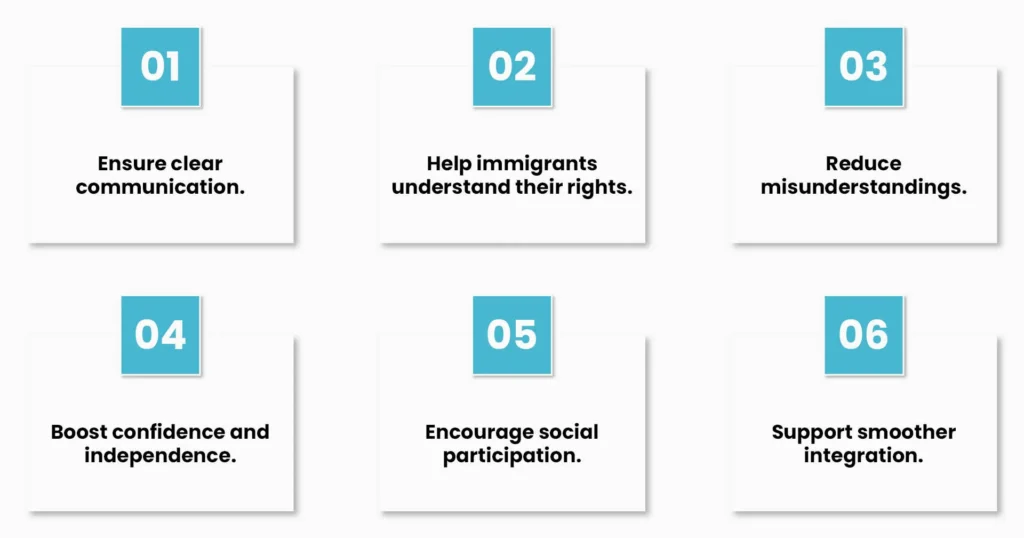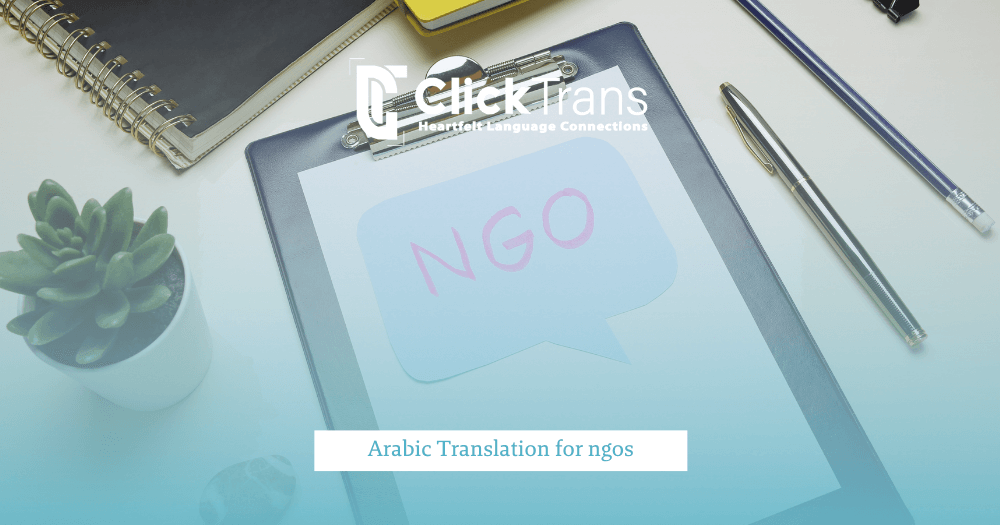Table of Contents
One of the most critical challenges that immigrants face when settling in a new country is assimilation.
Assimilation involves much more than learning a new language. It also means adapting to unfamiliar customs, systems, and social norms.
Struggling to learn the local language can impact immigrants both practically and emotionally, making day-to-day life more difficult.
In this blog, we explore the wide range of assimilation problems faced by immigrants and how language and translation can be key to successful integration.
Assimilation Problems Faced by Immigrants
Many immigrants initially believe that paperwork will be the only major hurdle when moving to a new country.
However, they are often shocked to find that assimilation problems faced by immigrants go far beyond bureaucracy — impacting nearly every aspect of daily life.
From communication struggles to cultural misunderstandings, the journey toward integration is filled with unexpected challenges.
Below are some of the most common barriers immigrants encounter as they try to adapt and build a new life.
Language Barriers
Language is the first and most overwhelming hurdle that any immigrant is likely to face.
Without strong communication skills, finding a job can be very challenging. Making friends is also tricky!
Every day tasks like visiting a doctor or helping children with their schoolwork become harder too.
Moreover, any misunderstanding due to language deficiency can lead to frustration. It can also result in missed opportunities.
For example, Emmanuel, 29, a Nigerian immigrant in the U.S, quoted:
“I missed a job interview because I didn’t fully understand the directions they gave me over the phone.”
Additionally, there can be even more dangerous situations, especially when dealing with healthcare or legal matters.
Cultural Differences
The adaptation of immigrants to new traditions, social expectations, and values can be disorienting.
Due to different cultural backgrounds across countries, what is considered polite or normal in one country may not be the same in another.
Immigrants face language and cultural barriers that can make everyday interactions feel stressful and uncertain.
For example, Sofia, a 41-year-old woman from Colombia who immigrated to Sweden, expressed her fear of the cultural differences, saying:
“I was always scared I’d say something wrong or offend someone without meaning to. Everything felt so unfamiliar.”
As a result, awkward interactions, unintentional offense, or feelings of alienation might occur. Over time, these experiences can contribute to cultural identity loss, as immigrants may feel pressured to suppress their original customs in order to avoid judgment or exclusion.
Discrimination and Stereotyping
Ethnicity, accent, religion, or appearance can lead to bias for many immigrants. This situation is likely to be encountered in schools, workplaces, housing, and everyday interactions.
Consequently, discrimination faced by immigrants can damage their self-esteem and discourage them from engaging with their new community.
Samir, a Lebanese immigrant who lived in the U.K., expressed how he feels discriminated against by saying:
“I felt invisible. I had the skills, the degree, but still got passed over for jobs because of my name.”
Employment and Recognition of Skills
Sometimes, skills are not enough in a foreign country to be employed. Your qualifications may not be recognized due to a language deficiency.
For example, Larissa, a 45-year-old Ukrainian qualified and skillful teacher who immigrated to the US, quoted the following after feeling employment challenges:
“I was a teacher for 10 years, but here, they told me I had to start all over again.”
Emmanuel’s Missed Interview: A Language Wake-Up Call
Emmanuel, a 29-year-old Nigerian immigrant, shared a painful moment that shaped his journey:
“I missed a job interview because I didn’t fully understand the directions. I waited at the wrong bus stop, thinking I was in the right place.”
Despite being prepared and hopeful, a simple misunderstanding cost him a valuable opportunity. That day, he realized how deeply language barriers could impact his future — not just in daily life, but in chasing his dreams.
Why Do Many Immigrants Struggle With Assimilation?
Assimilation is often expected to happen for immigrants at the beginning of their journey.
The struggle is not just about learning a new language or adapting to different habits; it is also about embracing a new culture.
As many immigrants struggle with assimilation for the following reasons:
- Adjusting to the new culture while maintaining their language and traditions can be a struggle, which may lead to conflict, guilt, and confusion.
- Feeling how hard assimilation is when they don’t have access to reliable information, legal help, or culturally sensitive support systems.
- Undertaking activities such as finding housing, understanding local laws, or enrolling in school may make them feel overwhelmed and unsafe.
- Facing economic hardships due to the issuance of work permits and visa restrictions, which add stress and delay the process of settling into a new life.
- Finding limited job opportunities, resulting in unstable or underpaid work, even if they are qualified and experienced.
What Are the Main Challenges Faced by Immigrants in the U.S.?
Immigrants in the U.S. face a wide range of challenges that affect their ability to integrate into society. These include systemic obstacles and personal hardships, many of which fall under the broader category of assimilation problems faced by immigrants, reflecting the everyday difficulties immigrants face while trying to build a new life.
These issues also highlight the deeper hardships of immigrants, which are often interconnected and rooted in both structural inequalities and the daily realities of adapting to a new culture.
1. Systemic Barriers
Immigrants often encounter structural difficulties related to:
- Legal complexities. Such as visa limitations, lengthy immigration processes, and limited access to legal support.
- Economic inequality. Including limited job opportunities, wage disparities, and difficulty accessing credit or housing.
- Social systems. Public services, such as healthcare, education, and welfare, may be challenging to navigate or inaccessible.
2. Language and Employment
One of the most pressing assimilation problems faced by immigrants is language. Limited English proficiency can create significant barriers in both professional and personal life:
- Communication. Difficulty communicating in professional, medical, or legal settings.
- Employment gaps. Restricted access to the job market, especially in skilled professions.
- Workplace inequality. Underemployment and exploitation in low-wage sectors.
3. Social Exclusion
Social integration is often hindered by:
- Affect day-to-day interactions and access to opportunities.
- Which fosters fear, mistrust, and exclusion.
- Cultural gaps. Makes it more challenging to build connections and feel a sense of acceptance.
How Does Assimilation Affect Immigrants Emotionally and Practically?
Assimilation is a complex and often emotionally taxing journey for many immigrants. It involves adjusting to new cultural norms, expectations, and systems, all of which can take a toll both personally and practically. The emotional effects of assimilation are especially significant, as immigrants try to balance between two worlds while feeling the pressure to adapt.
- Emotional impact. Many immigrants experience intense feelings of stress, homesickness, and culture shock. Over time, these emotions can contribute to anxiety or depression, especially when support systems are limited or absent.
Jorge, a 24-year-old Mexican immigrant living in Canada, had experienced it all. As he expressed himself, saying:
“I didn’t think learning the language would be this hard. Some days, I just sat on the bus in silence because I was too afraid to speak.”
- Practical setbacks. Assimilation can hinder progress in key areas, including employment, education, and housing. Immigrants may face challenges in having their qualifications recognized, accessing opportunities, or securing stable living conditions.
- Family and cultural shifts. Adapting to a new culture often leads to changes in family roles and values. Generational gaps may widen, and traditional norms may be challenged, leading to increased emotional tension within households.
Why Is Language the Key to Successful Assimilation?
Language plays a central role in the assimilation process and is often at the heart of many assimilation problems faced by immigrants. It serves as a bridge between newcomers and the society they are trying to integrate into.
- Language provides access to essential areas, including employment, education, healthcare, and public services. Without strong language skills, navigating these systems becomes a daily challenge.
- Building social connections, forming relationships, and fostering a sense of belonging and inclusion always require good communication skills. Practicing language helps immigrants move beyond isolation and develop a sense of community.
- Poor communication can lead to misunderstandings in medical, legal, or professional settings, with real-life consequences. It can also delay progress and increase feelings of frustration or exclusion.
How Can Professional Translation Services Support the Assimilation Process?
- Ensure clear communication in legal, medical, and educational settings.
- Help immigrants understand their rights, duties, and important documents.
- Reduce misunderstandings and prevent serious consequences.
- Boost confidence and independence in daily life.
- Encourage social participation and community involvement.
- Support smoother integration into society.
The importance of translation in assimilation lies in its ability to remove language as a barrier to opportunity, safety, and belonging ,At ClickTrans, we believe that language should never be a barrier to building a new life. Our professional translation and localization services ensure that immigrants can access crucial information, understand their rights, and communicate confidently in their new communities.
Whether it’s translating legal documents, medical records, or school forms, ClickTrans is here to support smoother integration and help every individual feel informed, empowered, and included.
Ready to get started? Request a free consultation or quote today.
Looking for accurate, certified, and fast translations?
Contact us today and request a free quote.
Should Immigrants Assimilate?
It’s a tricky question and one that many people get wrong. Successful integration values cultural diversity rather than eliminating it. Adapting to a new society doesn’t mean giving up one’s roots. Immigrants can learn the language, follow the laws, and participate in civic life while preserving their customs, traditions, and beliefs.
You May Also Like:Translation Birth Certificate USCIS
Conclusion
Assimilation and cultural adoption create several challenges for immigrants and other minority groups.
These assimilation problems faced by immigrants can be psychologically demanding, often leading to anxiety, depression, and identity confusion.
Starting by investing in language access andand localization services is essential to support integration.
It helps build trust and ensures every immigrant has the tools to succeed. This investment also allows them to feel at home in their new community.
FAQs
Assimilation means fully adopting the host culture, often losing aspects of one’s original identity. Integration allows immigrants to adapt while preserving their cultural heritage.
No. Many immigrants prefer to integrate, participating in society while retaining their language, traditions, and values.
Younger immigrants typically learn the language faster and adjust to local customs more easily, primarily through schools and peer interaction.
Supportive policies, such as language access, anti-discrimination laws, and inclusive services, help reduce barriers and promote smoother integration.
They eliminate language barriers, ensure understanding of essential documents, and support communication in critical areas like healthcare and employment. Is assimilation different from integration?
Do all immigrants want to assimilate?
Why do immigrants at a younger age adapt more easily?
How can policies play a crucial role in easing assimilation?
How do translation services help immigrants integrate faster?








